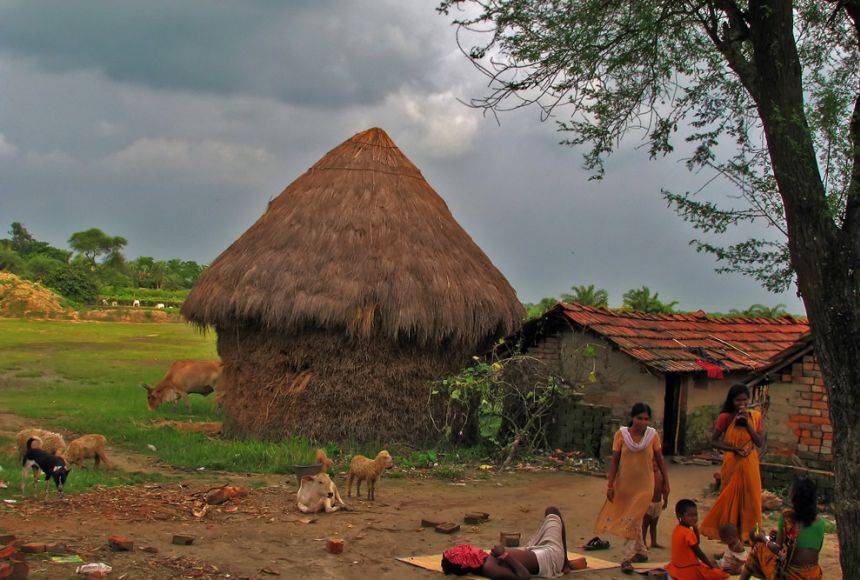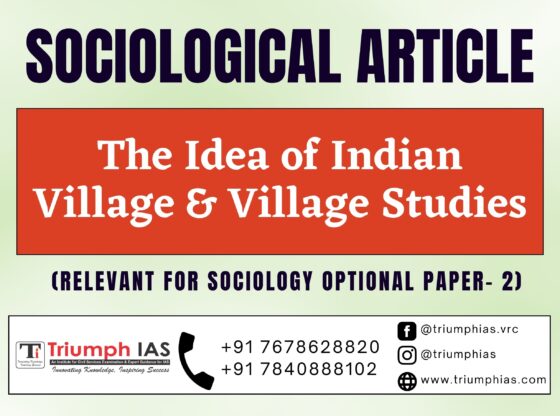The Idea of Indian Village & Village Studies
Relevant for sociology optional Paper- 2 (Unit- 12 : Social Structure)

The concept of the Indian village has been an integral part of the Indian society for thousands of years. It is believed that the Indian village, with its self-sufficient economy, communal lifestyle, and tradition of social harmony, has been the foundation of the country’s social and cultural fabric. The Indian village has always been viewed as a microcosm of the Indian society, with its unique blend of customs, traditions, and beliefs.
The idea of the Indian village has been deeply rooted in the country’s history and culture. It has been a source of inspiration for artists, writers, and filmmakers who have depicted the village life in their works. The Indian village has also been a subject of study for social scientists who have explored its social, economic, and cultural dimensions. The study of the Indian village has been an important part of the academic discourse in India, with scholars from various disciplines examining the village from different perspectives.
The idea of the Indian village has been closely associated with Mahatma Gandhi, who saw the village as the soul of India. Gandhi believed that the Indian village, with its close-knit community and self-sufficient economy, was the ideal model for a just and equitable society. He envisioned a decentralized India, where the power was distributed among the villages, and the people were empowered to make decisions that affected their lives. Gandhi’s vision of a self-reliant and self-sufficient village economy, based on cottage industries and small-scale agriculture, has been a source of inspiration for generations of Indians.
The idea of the Indian village was also central to the Nehruvian vision of modern India. Jawaharlal Nehru, India’s first prime minister, saw the village as a symbol of backwardness and poverty, which needed to be transformed through modernization and industrialization. Nehru believed that the village could be modernized through the introduction of science and technology, and the creation of a modern infrastructure. He saw the village as an integral part of the national economy, which needed to be integrated with the larger national and global markets.
The study of the Indian village has been an important part of the academic discourse in India. Village studies, as a field of inquiry, emerged in the 1950s and 1960s, with scholars from various disciplines exploring the social, economic, and cultural dimensions of the Indian village. The village studies were an attempt to understand the complexities of the village life, and the factors that shaped its social and economic structure.
The village studies have contributed significantly to our understanding of the Indian village. They have shown that the Indian village is not a homogeneous entity, but a complex social and economic system, with its own unique characteristics and dynamics. The village studies have highlighted the diversity of the Indian village, and the variations in its social and economic structures across different regions of the country. The village studies have also shown that the Indian village is not isolated from the larger national and global forces, but is influenced by them in complex ways.
The village studies have also highlighted the challenges facing the Indian village in the contemporary era. The Indian village is facing a range of problems, including poverty, unemployment, environmental degradation, and social dislocation. The village studies have shown that the solutions to these problems lie in a holistic approach that takes into account the social, economic, and environmental dimensions of the village life. The village studies have also highlighted the need for the empowerment of the rural poor, and the creation of opportunities for their participation in the larger national and global economies.
The Indian village has been the subject of much debate and discussion in the contemporary era. The village is seen by some as a relic of the past, a symbol of backwardness and poverty, which needs to be transformed through modernization and industrialization. Others see the village as a vital component of the Indian society, with its own unique identity and way of life, which needs to be preserved and protected. They argue that the village can be transformed through appropriate policies and interventions, which take into account the social, economic, and cultural dimensions of the village life.
The idea of the Indian village and the village studies have played an important role in shaping our understanding of the Indian society. They have highlighted the diversity, complexity, and richness of the Indian village, and the challenges facing it in the contemporary era. The idea of the Indian village has also been a source of inspiration for policymakers, activists, and scholars who seek to address the challenges facing the rural poor in India.
In conclusion, the idea of the Indian village and the village studies have been an important part of the academic discourse in India. They have contributed significantly to our understanding of the Indian society, and the challenges facing the rural poor. The Indian village is a complex social and economic system, with its own unique characteristics and dynamics. It is a vital component of the Indian society, which needs to be preserved and protected. The village can be transformed through appropriate policies and interventions, which take into account the social, economic, and cultural dimensions of the village life. The idea of the Indian village and the village studies will continue to play an important role in shaping our understanding of the Indian society in the years to come.
For more such free UPSC notes, Articles, News & Views Join our Telegram Channel. https://t.me/triumphias
Click the link below to see the details about the UPSC – Civils courses offered by Triumph IAS. https://triumphias.com/pages-all-courses.php


